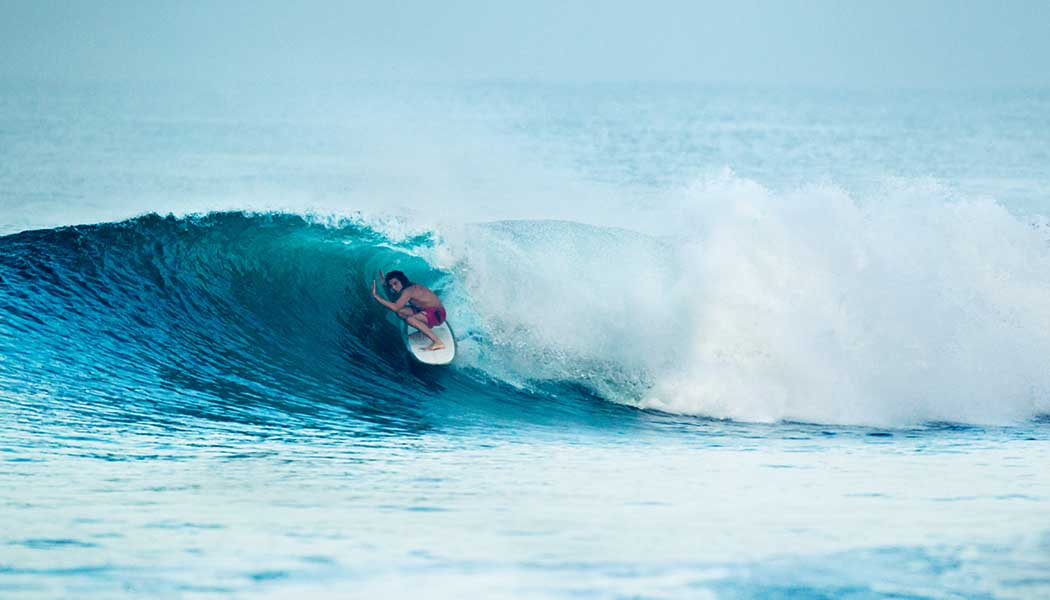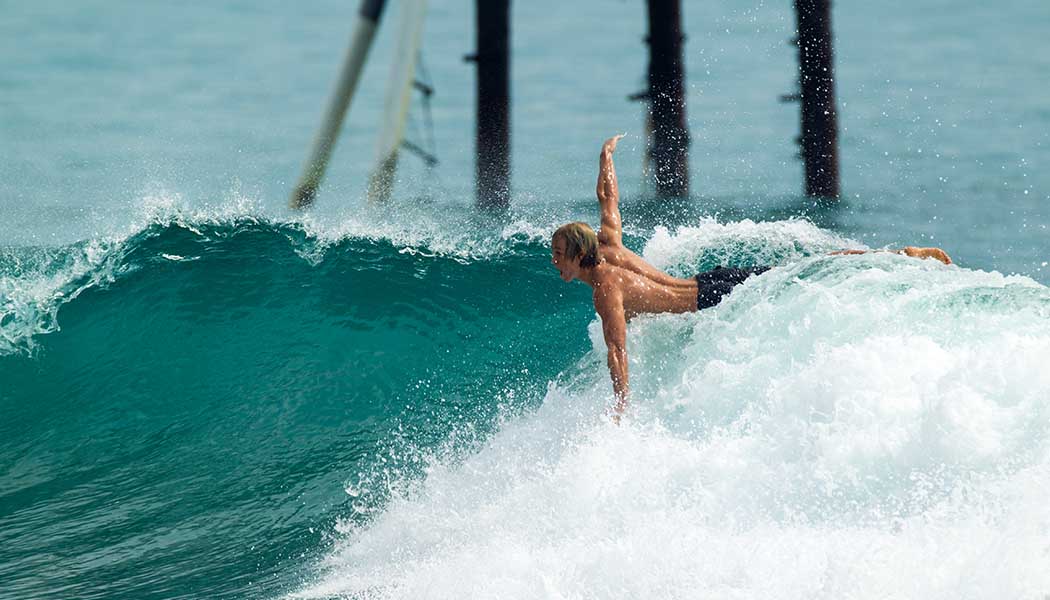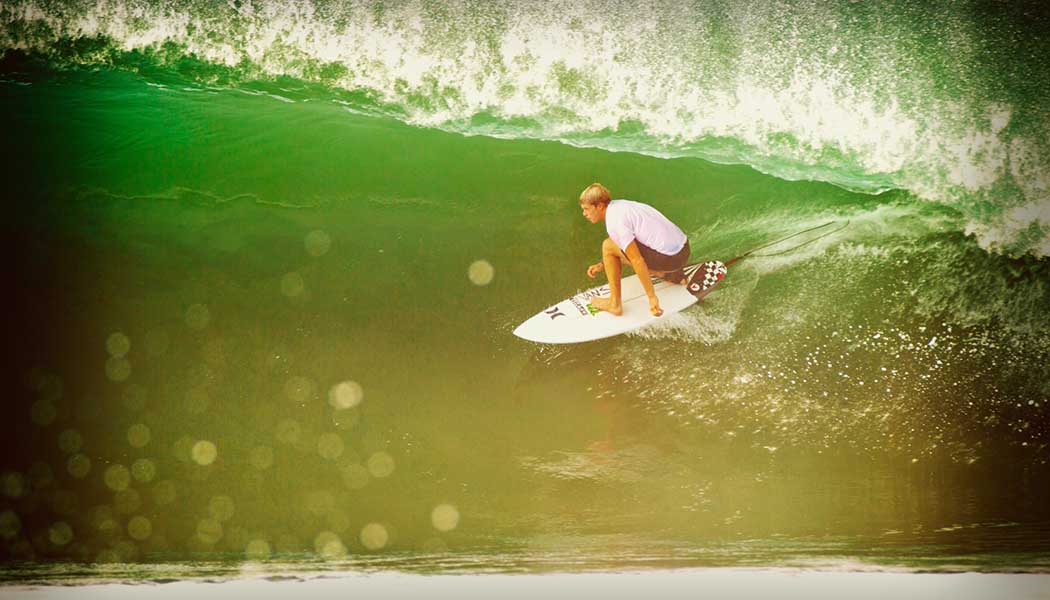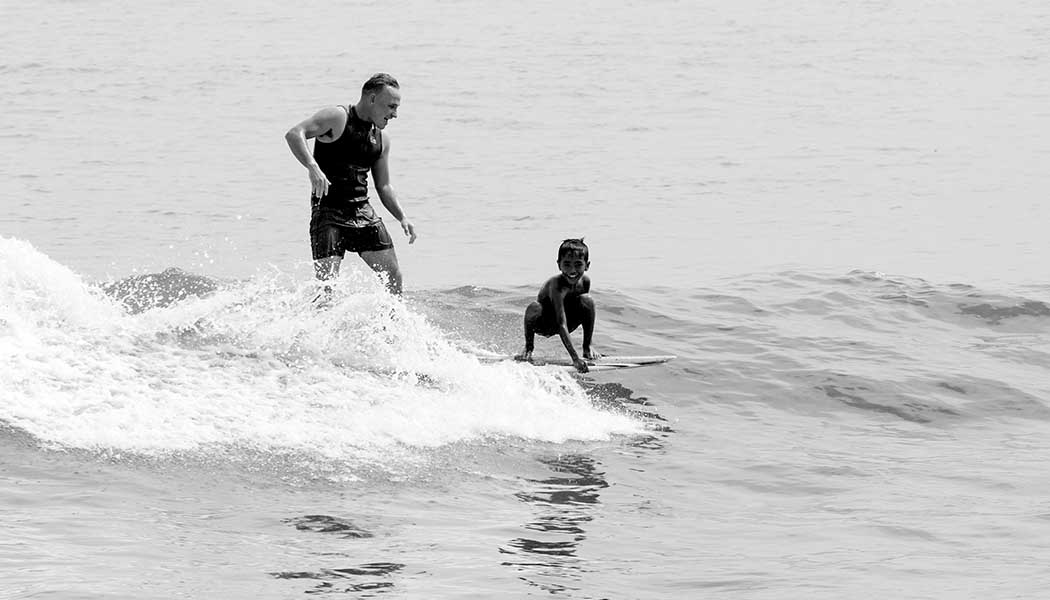“All surfers are made equal … but some are more equal than others.” To compete or simply live the life that the oceans and fate hands you … that is the question. Words: Tim Hain, Andrew E. Hall. Images: Anthony Dodds.
Duke Paoa Kahinu Mokoe Hulikohola Kahanamoku is generally acknowledged as the one who took the surfboard out of Hawaii and into the rest of the world.
Named after his father (who received the name from an Hawaiian princess in honour of a British prince) in 1890, Duke became an Olympic swimmer on the U.S. team – winning a brace of gold and silver medals in Olympiads from 1912 to 1924. In between competitions he travelled the world giving swimming and surfing exhibitions.
In Sydney in 1914 he went to a hardware store and procured a lump of pine from which he fashioned a long board and put on a surfing exhibition at Freshwater Beach . . . an event that changed the lives of hundreds of thousands of Australians. Forever after, the long board has been referred to affectionately as a “plank”. Duke’s plank still graces the Freshwater Surf Club, as does a statue of the great man . . . who was obviously selected by Hui – the surf god – to bring the art of surfing (which had been a mere pastime for Hawaiian kids) to the millions who came after him in the wider world.
Duke Kahanamoku was the first person to be inducted into the Swimming Hall of Fame as well as the Surfing Hall of Fame. And now, sitting at the right hand of Hui, he’s probably pretty happy with the millions of lives he has directly or indirectly touched . . . and the counter-culture he inspired.
Flash forward to 2009 and the surf movie Second Thoughts – an account by Timmy Turner of he and his friends Brett Schwartz and Travis Potter’s month-long near death mission to surf perfect waves on an uninhabited Indonesian island. Surviving on nothing but rice, dried noodles and the occasional fish, capturing rainwater to drink, bitten by mosquitoes, and afflicted with grossly infected reef cuts – that ended up with Timmy contracting a strange brain infection that almost killed him – these feral surfers are the modern day ambassadors for a lifestyle that has a certain appeal throughout the globe . . . albeit that their equipment is somewhat more sophisticated than in Duke’s day.
A lifestyle that proclaims that all surfers are equal . . . but some are more equal than others.
Surfers are born not made it seems, as history reveals that the majority of the world’s best surfers showed natural skills while barely out of their diapers. So with all that talent just boiling over and seeking some sort of direction, what is it that eventually has one surfer taking what we call the “free surfers” path, while the other chooses to become a professional contest surfer?
At its roots, the principle is the same, right? Just get up on a surfboard and ride the wave, letting your inner creativity express itself as the wave presents its various options in front of you, rather like the artist/painter who picks up a brush and then paints whatever he feels like on whatever medium he has chosen. The only limitation is your imagination, coupled with your physical ability.
It’s quite easy to identify a free surfer with an artist/painter, as they both pursue a feeling without the constraints of any formal boundaries. But what about the pro surfer, for whom there are many rigid requirements ¬– times, places, judging criteria, rules and other organisational strictures that seem contrary in a sport that should be all about freedom. Freedom of expression, freedom of movement, freedom of choice, freedom to enjoy being out in nature taking what comes and going with the flow.
It makes perfect sense when we think of surfers getting paid to travel to exotic tropical locations or even cold remote areas with giant waves with a couple of cameramen, and coming back with a film about their adventures, a la National Geographic. This fits well with people’s impression of surfing as adventure, freedom, travel, and challenging one’s self against whatever nature throws at them.
Contrast that with a scene here in Bali for a couple of weeks in June at Keramas Beach. Security guards, judging towers, protected “surfers only” zones, hundreds of cameras shooting from every angle, jet skis, flags, buoys, horns blowing, and MCs announcing every move of each of the world’s top professional surfers competing for prize money, points, and salary bonuses in a well-oiled contest machine dynamic.
As a professional sport, surfing is not like most other pro sports. Imagine a basket ball player being judged on how he dribbles, dodges other players, spins around, goes up for his shot, and then if he makes it or not … all by a panel of judges.
With pro surfing it is far more subjective. There are five judges, with a head judge presiding, watching a guy (or girl) surfing and they rate him/her on wave selection, size of the wave, how critical the maneuver, how many critical maneuvers, and the measure of control while attempting these maneuvers . . . all in a few seconds . . . and each give their opinion on a point scale of one to 10. The scores are all lined up with the highest and lowest thrown out and the rest averaged together for a final wave score. And this for every wave during a heat, which can last from 15 to 40 minutes, and for as many as eight heats in a competition.
Strategy, tactics, training, coaching, health, analysis, all become part of the equation when the top surfers in the world compete in contests . . . with the added pressure from their sponsors to perform.
Sound like a high-pressure job to you too?
So why would a free spirited “grommie” surfer who started out playing around in the water with his or her mates just for fun at the local beachbreak, end up putting him- or herself into a competitive pressure cooker?
Simply put, just like people the world over there are surfers who thrive with structure and those who don’t. But they are still surfers in the end. Competition brings with it the need to train, to learn the rules, to have clarity and keen judgment under stress in order to win, so there are surfers that compete because it satisfies an inner drive.
Dane Reynolds is arguably the most exciting and progressive free surfer on the planet, (even 11-time world champion, Kelly Slater, once said that Reynolds was the best surfer in the world) and he finds competition very limiting to the creativity of the sport. His style is to push boundaries by doing seemingly impossible maneuvers in any and all types of wave conditions. In a Rolling Stone article a couple of years ago he says: “I prefer to see surfing as an art as apposed to a sport. It’s such a rad thing that I think it’s crazy to confine it to a certain criteria.”

Reynolds did compete on the ASP Tour for a time, but in the same article he said, “… I don’t really see the importance of being a world champion. It’s just a title, it’s just a trophy.”
On the other hand, there is some chatter about introducing surfing as an Olympic sport, which would add the allure of national representation and national pride into the already complex mix of competitive surfing. What would The Duke think of this?
Mick Fanning – the current number-one-ranked ASP Tour surfer – is 32 years old and lives in Tweed Heads on the Australian Gold Coast. He says of the comparison between free surfing and competition:
“They are both amazing. Free surfing is the lifestyle. If I didn’t compete I’d still surf. You don’t wake up and think that you’ll stop surfing because there’s no competition.
In competitive surfing, it’s all about testing yourself, trying to put into practice everything you’ve trained for throughout the year. When that moment comes, you need to keep everything together, that’s really the fulfillment.”
Mick says the main element in being a successful competitive surfer is willpower . . .

“You know . . . that will to win; that will to keep going, even on the days you don’t want to get up and go to work. You just have to kick yourself and realise what you’re doing, and those are the days that pay off . . . but you have to remember that while winning is great, it’s nothing unless you enjoy the journey.”
On whether surfing should be an Olympic sport, Mick isn’t too sure.
“I think it’s different to every other sport, as in it relies on Mother Nature a lot and most of the other sports don’t, so that is the difficulty,” he says.
“If they could perfect a wave pool then yes, but when we look at where most of the Olympics are held, it seems very unlikely.”

Joel Parkinson is 32 years old, married, has three children, and also lives in Tweed Heads. He was the 2012 ASP World Champion, four-time runner up, and winner of the recent Oakley Pro Bali 2013.
In between competitions Joel gets out on his plank for the sheer enjoyment of the free surfing experience. He reckons the best wave on Bali is at Keramas – which is not surprising because that’s where Oakley Pro was staged.
On surfing becoming an Olympic sport he says: “I think it could work. Maybe we should have some trials to see what happens. It would be cool to be surfing for your country though, for sure.”
Twenty-year-old Hawaiian surfer John John Florence won the ASP Rookie of the Year honors last year. He’s tipped to be a future world champ.
“I think surfing can be an Olympic sport someday,” he says.
“. . . but now it’s kinda hard because of the way it is. It’s not a skateboard ramp, it’s not a snowboard jump, it’s not a swimming pool – you depend on what Mother Nature gives you. I think that in the future when wave pools come along it will be, when we have big stadiums around pools and stuff.
“I think it’s more fun to compete in a natural environment, because guys are winning heats based on their knowledge of the ocean, based on knowing where to sit, and not looking at someone in a stadium telling them where to go. That makes it fun, interesting and exciting.
“But I think someday it will be fun because you’re in a wave pool and people will be trying crazy things, because you have the same section to do things over and over again. It’s going to push the boundaries of surfing.”
Kassia Meador is sponsored by Roxy, Swatch, Raen, Stance, Gravis, Captain Fin, Frends. She’s a Californian surfer with a big personality and an even bigger heart.
“To me surfing is the most empowering lifestyle to embrace as a woman . . . it’s the perfect blend of strength and grace, and the guys in the line up are always happy to share waves and good vibes with us lady sliders,” she says.
So, free surfing or competition we ask . . .
“Free surfing all the way. By nature I’m not a very competitive person. I always like to do my best but it’s more about pushing myself than beating other people . . .
I surf to get away from the rules, pressures and restrictions of the real world. In the ocean we’re free to do as we please.”
And that is why Kassia is heavily into her planks.
“I just love how long boards feel in the water. The glide, the dance, the balance of it all feels so magical under my feet,” she says.
As a competitive grom, Harrison Roach was told to choose: short or long.
“People told me you can’t succeed at either if you’re trying to do both,” Harrison says.
“But I wasn’t worried about succeeding, so it was easy to just have fun . . . in the end I just spent twice as long in the water as everyone else.”
He doesn’t have an opinion either way about where to take the competitive future of the sport because he reckons that free surfing will always be better than competition surfing.
Jack Robinson is a 15-year-old from Margaret River in Western Australia, who started surfing at three-and-a-half. Margaret River is one of the venues on the ASP Tour and is renowned for having some bloody big waves.
“It’s a lot of fun . . . great training ground,” he says.
Jack started competing when he was about seven and is currently sponsored by Quiksilver, Nike and Oakley. His schooling is taking place at home – or wherever he happens to be on the competition circuit. Jack is too cool for school, and has some adivice for those times when Mother Nature wins the battle:
“Stay calm, that’s the main thing . . .
because you’re going to get really smashed.”
Right now he’s too focused on developing his skills – that he describes as, “turns, barrels and ‘airs’ . . . but I got to be careful with my ankle, because I had an injury about eight months ago and dislocated it so… that’s the worst injury I’ve had. It took a long time to come good, so I’m backing off on the air right now” – to worry about whether he’s going to represent his country at some time in the future.
Most surfers in the world won’t ever have to worry about making a career choice between being a free surfer or a competitive surfer – for them it will remain a hobby, however time-consuming it may be turn out to be.
So be it sport or art, the goal of this hobby is to be out in the water catching a few waves, completely removed from the concrete realities of our often mundane and pressure-filled lives.











































